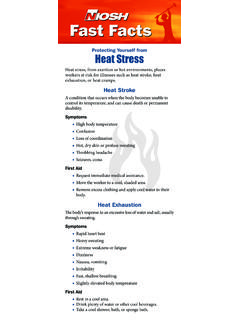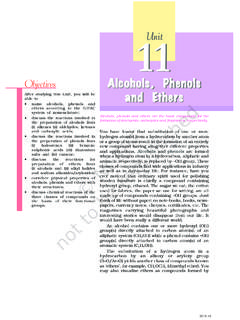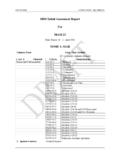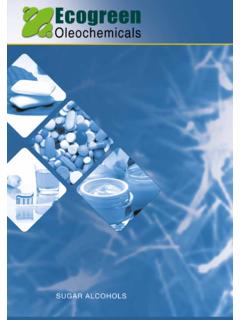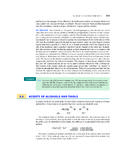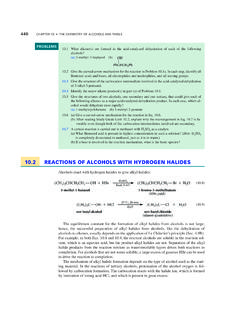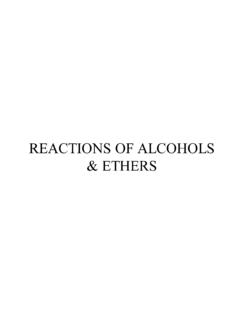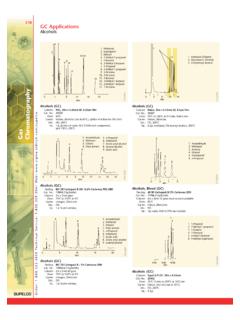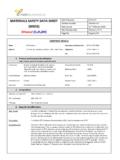Transcription of ALCOHOLS III 1402
1 ALCOHOLS III1402 Table 1 MW: Table CAS: Table 2 RTECS: Table 2 METHOD: 1402, Issue 2 EVALUATION: PARTIALI ssue 1: 15 February 1984 Issue 2: 15 August 1994 OSHA :Table 2 NIOSH:Table 2 ACGIH:Table 2 PROPERTIES: Table 1 COMPOUNDS(1) allyl alcohol:2-propen-1-ol; 2-propenol; vinyl carbinol. and(2) diacetone alcohol:4-hydroxy-4-methyl-2-pentanone; :(3) cyclohexanol:hexalin; hydralin; hydroxycyclohexane; anol.(4) isoamyl alcohol:3-methyl-1-butanol; isobutylcarbinol; isopentyl alcohol.(5) methyl isobutyl carbinol:MIBC; 4-methyl-2-pentanol; methyl amyl :SOLID SORBENT TUBE(coconut shell charcoal, 100 mg/50 mg)FLOW to L/minVOL-MIN: 1 L -MAX:10 LSHIPMENT:routineSAMPLE STABILITY:unknown; store in freezerBLANKS:2 to 10 field blanks per setMEASUREMENTTECHNIQUE:GAS CHROMATOGRAPHY, FIDANALYTE:compounds aboveDESORPTION:1 mL 5% 2-propanol in CS2.
2 30 minINJECTION VOLUME:5 LTEMPERATURE-INJECTION:200 C -DETECTOR:250-300 C -COLUMN: 80-120 CCARRIER GAS:N2 or He, 30 mL/minCOLUMN:glass, 3 m x 2-mm ID, 10% SP-1000 on80/100 mesh Supelcoport or equivalentCALIBRATION:solutions of analyte in eluent (internalstandard optional)RANGE ANDPRECISION:see EVALUATION OF METHODESTIMATED mg per sample [2]ACCURACYRANGE STUDIED:see EVALUATION OF METHODBIAS:see EVALUATION OF METHODOVERALL PRECISION (S rT): see EVALUATION OFMETHODACCURACY: 20%APPLICABILITY: The working range is 1 to 10 mg/m3 for allyl alcohol (other analytes range from 45 to 140 mg/m3 at low endand 175 to 680 mg/m3 at high end of working ranges) for a 10-L air sample.
3 This method may be used to determine two or moreanalytes simultaneously by varying GC conditions ( , temperature programming).INTERFERENCES: High humidity reduces sampling capacity. The methods were validated using a 3 m x 3-mm stainless steelcolumn packed with 10% FFAP on Chromosorb W-AW; other columns with equal or better resolution ( , capillary) may be volatile compounds may displace more volatile compounds on the METHODS: This method combines and replaces Methods S52, S55, S54, S58 and S60 [3].NIOSH Manual of Analytical Methods (NMAM), Fourth Edition, 8/15/94 ALCOHOLS III: METHOD 1402, Issue 2, dated 15 August 1994 - Page 2 of 4 : Carbon disulfide* (chromatographic)with 5% (v/v) 2-propanol and (v/v)hexane, (v/v) n-pentadecane or othersuitable internal stock solution, allyl alcohol, 12 mg/mL , , , compressed, filtered.
4 *See SPECIAL : : glass tube, 7 cm long, 6-mm OD,4-mm ID, flame-sealed ends, containing twosections of activated (600 C) coconut shellcharcoal (front = 100 mg; back - 50 mg)separated by a 2-mm urethane foam plug. Asilylated glass wool plug precedes the frontsection and a 3-mm urethane foam plugfollows the back section. Pressure dropacross the tube at 1 L/min airflow must beless than kPa. Tubes are commerciallyavailable. sampling pump, to L/min,with flexible connecting tubing.
5 Chromatograph, FID, integrator andcolumn (page 1402-1). , glass, 2-mL, PTFE-lined crimp caps. , 10- L, readable to L. flasks, PRECAUTIONS: Carbon disulfide is toxic and an acute fire and explosion hazard (flash point= -30 C); all work with it must be done in a each personal sampling pump with a representative sampler in the ends of the sampler immediately before sampling. Attach sampler to personalsampling pump with flexible at an accurately known flow rate between and L/min for a total sample size of1 to 10 the samplers with plastic (not rubber) caps and pack securely for the front and back sorbent sections of the sampler tube in separate vials.
6 Discard theglass wool and foam mL eluent to each vial. Attach crimp cap to each to stand 30 min with occasional AND QUALITY daily with at least six working standards covering the range of the known amounts of analyte or calibration stock solution to eluent in 10-mL volumetricflasks and dilute to the together with samples and blanks (steps 11 and 12). calibration graph (ratio of peak area of analyte to peak area of internal standard analyte). desorption efficiency (DE) at least once for each batch of charcoal used for samplingin the calibration range (step 8).
7 Prepare three tubes at each of five levels plus three Manual of Analytical Methods (NMAM), Fourth Edition, 8/15/94 ALCOHOLS III: METHOD 1402, Issue 2, dated 15 August 1994 - Page 3 of and discard back sorbent section of a media blank a known amount of analyte or DE stock solution directly onto front sorbent sectionwith a microliter the tube. Allow to stand (steps 5 through 7) and analyze together with working standards (steps 11 and 12). a graph of DE vs. mg analyte three quality control blind spikes and three analyst spikes to insure that the calibrationgraph and DE graph are in gas chromatograph according to manufacturer's recommendations and to conditions givenon page 1402-1.
8 Inject sample aliquot manually using solvent flush technique or :If peak area is above the linear range of the working standards, dilute with eluent,reanalyze and apply the appropriate dilution factor in peak area. Divide the peak area of analyte by the peak area of internal standard onthe same the mass, mg (corrected for DE) of analyte found in the sample front (Wf) and back(Wb) sorbent sections, and in the average media blank front (Bf) and back (Bb) sorbent :If Wb > Wf/10, report breakthrough and possible sample concentration, C, of analyte in the air volume sampled, V (L):EVALUATION OF METHOD.
9 Methods S52 (allyl alcohol), S55 (diacetone alcohol), S54 (cyclohexanol), S58 (isoamyl alcohol) and S60(methyl isobutyl carbinol) were issued on January 17, 1975 [3], and validated using 10-L air samples ofatmospheres generated in dry air by calibrated syringe drive from the pure substances [1]. No stabilitystudies were done. Precision and recovery were as shown below, representing non-significant bias ineach method: OverallMeasurementMethodPrecisionRecover y Range Studied BreakthroughAvg. Precision [1,3] (S rT) (%) mg/m3 mg per sample @ 2X OSHA DE (S r) to to >48 to to >48 95 to 3801 to 4 >48 to to 7 34 45 to to 2 >48 Manual of Analytical Methods (NMAM), Fourth Edition, 8/15/94 ALCOHOLS III: METHOD 1402, Issue 2, dated 15 August 1994 - Page 4 of 4 REFERENCES:[1]Documentation of the NIOSH Validation Tests, Department of Health, Education, andWelfare, Publ.
10 (NIOSH) 77-185 (1977).[2]User check, UBTL, NIOSH Sequence #3990-V (unpublished, November 4, 1983).[3]NIOSH Manual of Analytical Methods, 2nd ed., V. 2., Department of Health, Education, andWelfare, Publ. (NIOSH) 77-157-B (1977).METHOD REVISED BY:George Williamson, NIOSH/DPSE; methods originally validated under NIOSH Contract 1. PROPERTIES VP @ mg/m3 20 C,= 1 ppmDensity BP kPa Compound Formula @ NTP MW (g/mL) ( C) (mm Hg) Allyl alcohol CH2=CHCH2OH; (17) C3H6O@ 20 CDiacetone alcohol (CH3)2C(OH)CH2 COCH3; ( ) C6H12O2 @ 25 CCyclohexanol ; ( ) MP =24 Isoamyl alcohol(CH3)2 CHCH2CH2OH; (28)C5H12O@ 15 CMethyl isobutyl(CH3)2 CHCH2CH(OH)CH3; (3)carbinolC6H14 OTABLE 2.









